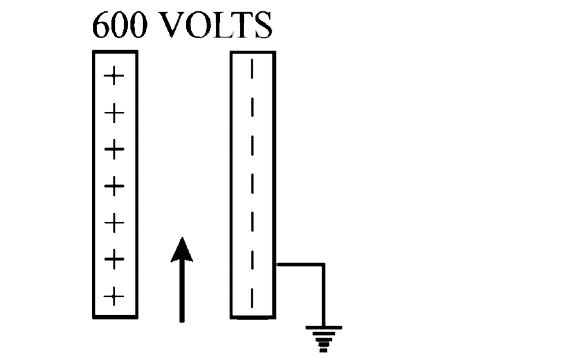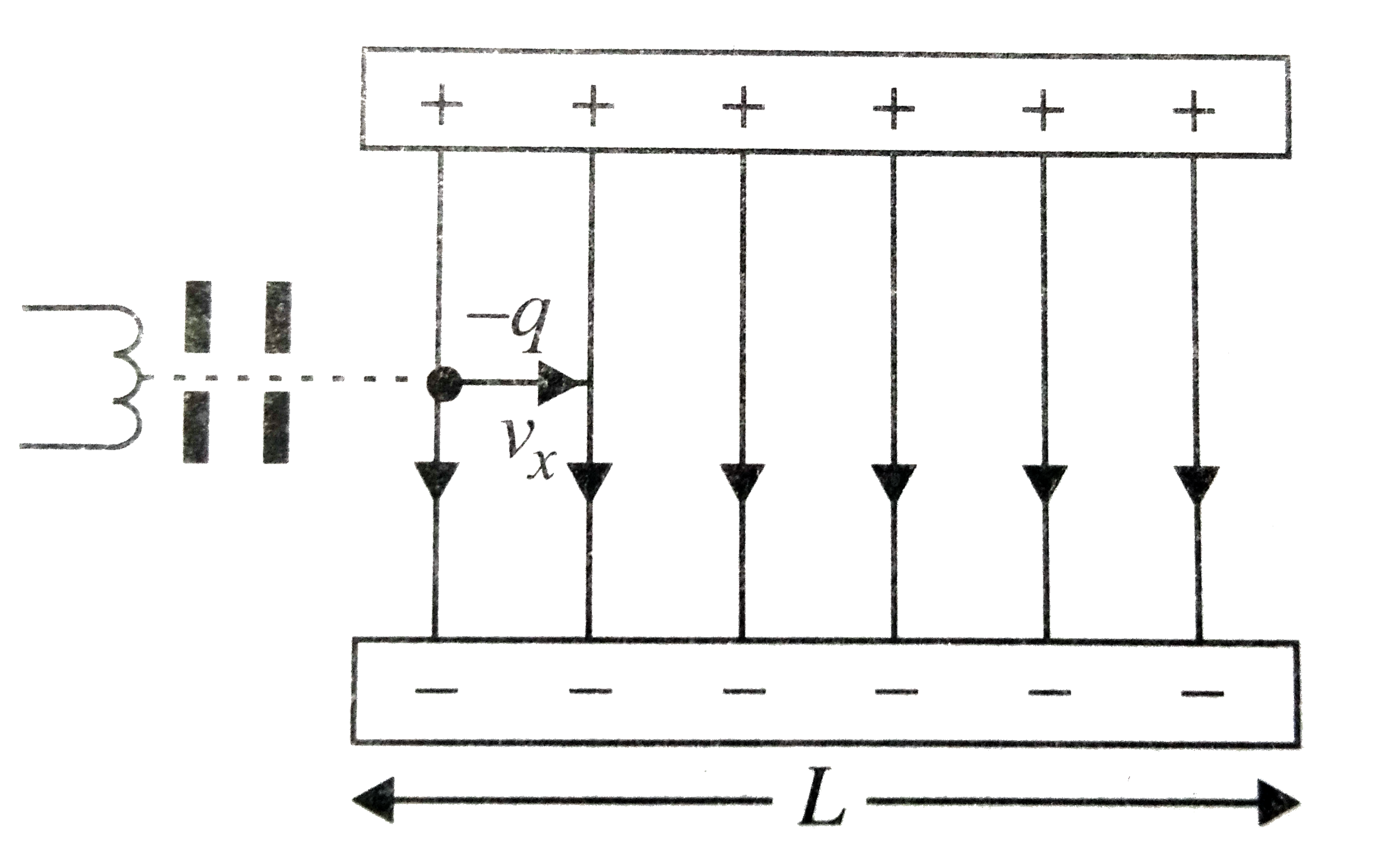A particle with unknown mass and charge moves with constant speed v = 1.9 x 106 m/s as it passes undeflected through a pair of parallel plates as shown above. The plates are separated by a distance d = 6.0 x 10–3 m and a constant potential difference V is maintained between them. A uniform magnetic field of magnitude B = 0.20 T directed into the page exists both between the plates and in a region to the right of them as shown. After the particle passes into the region to the right of the plates where only the magnetic field exists its trajectory is circular with radius r = 0.10 m.a. What is the sign of the charge of the particle? Check the appropriate space below.___ Positive ___ Negative ___ Neutral ___ It cannot be determined from this information.Justify your answer.b. On the diagram above clearly indicate the direction of the electric field between the plates.c. Determine the magnitude of the potential difference V between the plates.d. Determine the ratio of the charge to the mass q/m of the particle.
a Looking in the region where the particle curves the LHR gives the proper force direction so it’s a – chargeb To counteract the Fb downward an electric force must point upwards. For a negative charge an E field down makes an electric force upwards.c Find the E field and use V = Ed to get the V.Between the plates. … Fe = Fb … Eq = qvB … E = vB … now sub into V = Ed …V = vBd = 1.9x1060.26x10–3 = 2300 Vd FnetC = mv2/r … qvB = mv2 / r … q/m = v / rB … q/m = 1.9x106 / 0.10.2 = 9.5 x 107 C/kg
Related Solutions
A parallel -plate capacitor is connected to a battery that maintains a constant potential difference V between the plates. If the plates are pulled away from each other, increasing their separation, does the magnitude of the charge on the plates (a) increase, (b) decrease, or (c ) remain the same ?
View SolutionA potential difference of is applied across the plates of a parallel plate consenser . The separation between the plates is . An electron projected vertically, parallel to the plates , with a velocity of moves underflected between the plates. Find the magnitude and direction of the magnetic field in the region between the condenser plates. ( Neglect the edge effects). ( Charge of the electron = -1.6xx10^(-19) coulomb)

View SolutionA potential difference of 600V is applied across the plates of a parallel plate capacitor. The separation between the plates is 3mm. An electron is projected vertically, parallel to the plates, with a velociyt of 2 xx 10^(6)m//s moves undeflected between the plates. The magnitude and direction of magnetic field in the region between the capacitor plates is
View SolutionA potential difference of 500 V is applied across a paralle plate capacitor. The separation between the plates is . The plates of the capacitor are vertical. An electron is projected vertically upwards between the plates with a velocity of and it moves undeflected between the plates. The magnetic field acting perpendicular to the electric field has magnitude of
View SolutionA large plate with uniform surface charge density sigma is moving with constant speed v as shown in the figure. The magnetic field at a small distance from plate is
View SolutionIn a parallel capacitor the potential difference between the plates is ,A particle of mass and charge leaves the negative plate and reaches the positive plate at distance in time with a momentum .Then
View SolutionAn uniform electric field exists between two plates of a parallel plate condenser. The separation between the plates is 1 mm. If the potential difference is 100 V, find the magnitude of electric field.
View SolutionTwo parallel plates separated by distance d are kept at potential difference V volt. A charge q of mass m enters in parallel plates with some velocity. The acceleration of the charge particle will be
View SolutionElectrons are observed to be ejected in various directions with negligible speed from the negative plate of a parallel plate capacitor when the plate is illuminated by a certain wavelength. The plates are separated by a distance d and a potential difference V is maintained between them. Show that none of these electrons will reach the positive plate if a magnetic field is applied at right angles to the electric field and that the magnetic induction has a value where m and e are the electron mass and charge respectively.
View SolutionTwo parallel plates separated by a distance of 5 mm are kept at a potential difference of 50 V. A particle of mass and charge C enters in it with a velocity . The acceleration of the particle will be
View SolutionTwo parallel plates separated by a distance of 5 mm are kept at a potential difference of 50 V. A particle of mass and charge C enters in it with a velocity . The acceleration of the particle will be
View SolutionA particle of mass m and charge -q enters the region between the two charged plates initially moving along x-axis with speed as shown in figure. The length of plate is L and a uniform electric field E is maintained between the plates. The vertical deflection of the particle at the far edge of the plate is

View SolutionA charged particle of mass and charge is accelerated through a potential differences of volts. It enters of uniform magnetic field which is directed perpendicular to the direction of motion of the particle. The particle will move on a circular path of radius
View SolutionA charged particle of mass and charge is accelerated through a potential differences of volts. It enters of uniform magnetic field which is directed perpendicular to the direction of motion of the particle. The particle will move on a circular path of radius
View SolutionA charged particle with a velocity 2 xx 10^(3) m s^(-1) passes undeflected through electric field and magnetic fields in the mutually perpendicular directions. The magnetic field is 1.5 T. The magnitude of electric field will be
View SolutionIf the charge on a parallel plate capacitor remains the same, then how will the potential (V) between the plates depend on the distance (d) between them?
View Solutionयदि किसी समान्तर पट्टिका वाले संधारित्र पर आवेश एकसमान रहता है तो पट्टिकाओं के मध्य विभव (V) उनके बीच की दुरी (d) पर किस प्रकार से निर्भर करेगा ?
View SolutionThe area of a parallel plate capacitor is 6xx10^(-3)m^(2) . The distance of separation of two plates is 3xx10^(-3)m . Calculate the capacitance of the above capacitor. If the capacitor is charged to potential of 100 V then calculate the charge on each plate.
View SolutionA potential difference of 600 V is applied across the plates of a parallel plate condenser. The separation between the plates is 3 mm. An electron projected vertically, parallel to the plates, with a velocity of 2xx10^(6)m//s moves undeflected between the plates. Find the magnitude of the magnetic field (in T) in the region between the condenser plates. (Neglect the edge effects) square . (Charge of the electron =1.6xx10^(-19)C )
View SolutionTwo parallel plates separated by distance d are kept at potential differenc V volt. A charge q of mass m enters in parallel plates with some velocity. The acceleration of the charge particle will be
View Solution